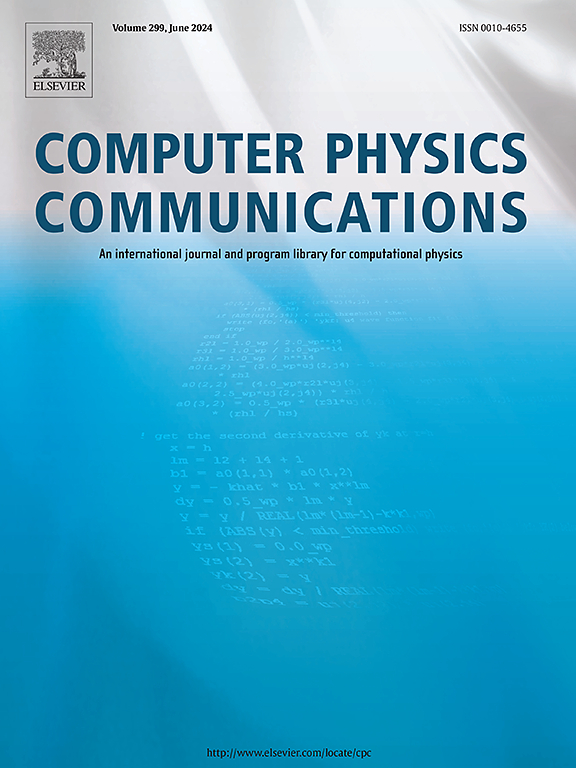Study of simplified conservation flux scheme for gas kinetics based on OpenFOAM framework II: Rykov model
IF 7.2
2区 物理与天体物理
Q1 COMPUTER SCIENCE, INTERDISCIPLINARY APPLICATIONS
引用次数: 0
Abstract
We present a computational fluid dynamics solver for diatomic gases, meticulously developed within the dugksFOAM framework. This solver is built upon a conservative gas kinetic scheme with simplified interface flux evaluations, enabling efficient and accurate solutions of the Rykov model equation. An unstructured discrete velocity space is introduced, in which the velocity points are strategically distributed to balance computational efficiency and numerical accuracy. A sophisticated hybrid parallelization strategy, referred to as X-space parallelization, has also been introduced. It integrates domain decomposition in both physical and velocity spaces, significantly enhancing computational efficiency in large-scale simulations. We further compare the computational efficiency between the structured and unstructured velocity space approaches, demonstrating that the unstructured configuration achieves notable reductions in computational cost without compromising accuracy. Moreover, the parallel performance of the solver is systematically evaluated under both small- and large-scale settings, showcasing excellent scalability and robustness. The accuracy and reliability of the solver are validated against a comprehensive set of benchmark cases, including shock structure problems, lid-driven cavity flow, supersonic flows past a flat plate, cylindrical blunt body, and sphere. These results convincingly confirm the solver's capability to capture a wide range of rarefied flow phenomena in diatomic gases, from one-dimensional to three-dimensional flows.
基于OpenFOAM框架II: Rykov模型的气体动力学守恒通量简化格式研究
我们提出了一个双原子气体的计算流体动力学求解器,在dugksFOAM框架内精心开发。该求解器建立在一个保守的气体动力学格式上,简化了界面通量评估,能够高效准确地求解Rykov模型方程。引入了一种非结构化离散速度空间,在该空间中,速度点被有策略地分布,以平衡计算效率和数值精度。还介绍了一种复杂的混合并行化策略,称为x空间并行化。它在物理空间和速度空间中集成了域分解,大大提高了大规模模拟的计算效率。我们进一步比较了结构化和非结构化速度空间方法的计算效率,表明非结构化配置在不影响精度的情况下显著降低了计算成本。此外,系统地评估了求解器在小规模和大规模环境下的并行性能,显示出良好的可扩展性和鲁棒性。通过一系列的基准案例验证了求解器的准确性和可靠性,包括激波结构问题、盖驱动腔流、超声速流过平板、圆柱形钝体和球体。这些结果令人信服地证实了求解器捕获双原子气体中从一维到三维流动的各种稀薄流动现象的能力。
本文章由计算机程序翻译,如有差异,请以英文原文为准。
求助全文
约1分钟内获得全文
求助全文
来源期刊

Computer Physics Communications
物理-计算机:跨学科应用
CiteScore
12.10
自引率
3.20%
发文量
287
审稿时长
5.3 months
期刊介绍:
The focus of CPC is on contemporary computational methods and techniques and their implementation, the effectiveness of which will normally be evidenced by the author(s) within the context of a substantive problem in physics. Within this setting CPC publishes two types of paper.
Computer Programs in Physics (CPiP)
These papers describe significant computer programs to be archived in the CPC Program Library which is held in the Mendeley Data repository. The submitted software must be covered by an approved open source licence. Papers and associated computer programs that address a problem of contemporary interest in physics that cannot be solved by current software are particularly encouraged.
Computational Physics Papers (CP)
These are research papers in, but are not limited to, the following themes across computational physics and related disciplines.
mathematical and numerical methods and algorithms;
computational models including those associated with the design, control and analysis of experiments; and
algebraic computation.
Each will normally include software implementation and performance details. The software implementation should, ideally, be available via GitHub, Zenodo or an institutional repository.In addition, research papers on the impact of advanced computer architecture and special purpose computers on computing in the physical sciences and software topics related to, and of importance in, the physical sciences may be considered.
 求助内容:
求助内容: 应助结果提醒方式:
应助结果提醒方式:


